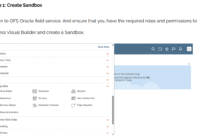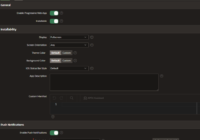At Conneqtion Group, we understand that moving enterprise content from legacy systems to modern platforms like Oracle WebCenter Content (WCC) on Oracle Cloud Infrastructure (OCI) isn’t just a technical task, it’s a strategic business initiative.
A successful migration impacts compliance, security, operational efficiency, and collaboration. That’s why we’ve developed a unique migration tool (Data Drift) to help organizations transition their critical data with confidence, control, and transparency.
Unlike complex command-line utilities, our migration tool provides a clean, intuitive interface designed to help IT teams and business stakeholders monitor and control the process – without needing to write a single line of code. Let’s explore how Data Drift works.
First, we need to provide the necessary configuration details for successful configuration as below:
 Once this is done, we will move forward to the next steps.
Once this is done, we will move forward to the next steps.
Here’s how we deliver value:
Step 1: Data Discovery and Security Baseline
Before migrating, the tool scans existing content to identify:
- All unique user and group permissions.
- All files and folders in scope.
- Any unsupported names or structures incompatible with WCC.
 Business value: This prevents security gaps and compliance issues from surfacing post-migration. It also gives stakeholders a clear view of what’s being migrated and how it’s secured.
Business value: This prevents security gaps and compliance issues from surfacing post-migration. It also gives stakeholders a clear view of what’s being migrated and how it’s secured.
Step 2: Pre-Migration Checks and Validation
We perform detailed checks to ensure:
- All files and folders are accounted.
- Naming conventions meet WCC standards.
- Potential errors are flagged before migration starts.
 Business value: Early detection reduces costly rework, prevents disruptions, and builds stakeholder trust in the process.
Business value: Early detection reduces costly rework, prevents disruptions, and builds stakeholder trust in the process.
Step 3: Structured Migration of Folders and Files
Instead of a “big bang” approach, our tool replicates folders and files in a controlled, step-wise process, providing:
- Progress visibility through reports.
- Retry mechanisms for any failed items.
- Audit logs for every action taken.

 Business value: This approach minimizes business disruption and ensures continuity even if migration spans days or weeks.
Business value: This approach minimizes business disruption and ensures continuity even if migration spans days or weeks.
Step 4: Preserving Security and Compliance
Our tool (Data Drift) ensures that migrated content retains its original permissions, ownership, and access controls. Security mappings from the source are applied to WCC to prevent unauthorized access.
 Business value: No surprises after go-live and the business units retain the same access controls they had before, avoiding costly access issues or compliance risks.
Business value: No surprises after go-live and the business units retain the same access controls they had before, avoiding costly access issues or compliance risks.
Step 5: Integrity Verification and Reporting
We run checksum validations to confirm that files migrated to WCC match exactly with their source versions. Any discrepancies are flagged, and automated retry mechanisms are available.
 Business value: Leadership and compliance teams gain assurance that content integrity has been maintained which is critical for audits, legal holds, or regulated industries.
Business value: Leadership and compliance teams gain assurance that content integrity has been maintained which is critical for audits, legal holds, or regulated industries.
Step 6: Delta Migration for Business Continuity
We know that businesses continue creating and modifying content even during migration. Data Drift supports incremental (delta) migration, moving only new or updated files since the last run.
 Business value: This eliminates downtime or content freezes, allowing business operations to continue uninterrupted while migration happens in the background.
Business value: This eliminates downtime or content freezes, allowing business operations to continue uninterrupted while migration happens in the background.
Conclusion
Our WCC Migration Tool (Data Drift) is engineered for speed, precision, and scalability. In recent production scenarios, with applying metadata and security permissions it has demonstrated the ability to replicate up to 500 folders per minute and migrate between 500 to 750 files per minute, depending on file size and network conditions. The threads utilized were 40 and hence can be increased with respect to system’s capacity.
Delta migrations which are used to capture new or modified content after the initial migration typically require less than 30% of the time of a full migration, enabling near-continuous business operations. The tool also includes robust retry logic, achieving a 99%+ success rate for previously failed items on the second attempt. Across multiple deployments, we’ve observed a post-validation error rate of less than 0.05%, making this tool both reliable and enterprise-grade. If you would like to know more about Data Drift and how it can help your Enterprise Content Migration, get in touch with us at [email protected].



